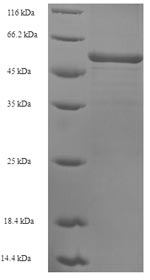Producing recombinant human sarcoplasmic/endoplasmic reticulum calcium ATPase 2 (ATP2A2) involves isolating the target gene, which corresponds to the 314-756aa of the human ATP2A2. This gene is cloned into an appropriate expression vector along with an N-terminal 6xHis-tag gene and transfected into E. coli cells. The positive E. coli cells are cultured under appropriate conditions to express the recombinant protein. These cells undergo lysis to harvest the recombinant ATP2A2 protein, which is subjected to affinity chromatography. The final step involves measuring the protein's purity through SDS-PAGE. Its purity is greater than 90%.
SERCA2, a crucial enzyme encoded by the ATP2A2 gene, is highly expressed in keratinocytes [1]. It maintains calcium homeostasis within cells by pumping calcium ions from the cytosol into the lumen of the sarcoplasmic reticulum (SR) and endoplasmic reticulum (ER) [2], which is essential for regulating intracellular calcium levels and preventing cytotoxic effects associated with high calcium concentrations [3]. Mutations in the ATP2A2 gene have been linked to conditions such as Darier disease, where dysfunctional SERCA2 leads to impaired calcium transport and subsequent ER stress and apoptosis in affected cells [4].
Dysregulation of SERCA2 activity can have significant implications, as seen in conditions like colorectal cancer, where targeting SERCA2 with specific molecules has shown promise in cancer treatment [5]. In cardiac function, SERCA2 plays a role in the force-frequency relationship and frequency-dependent acceleration of relaxation, crucial for maintaining proper ventricular filling at high heart rates [6].
References:
[1] A. Sakuntabhai, V. Ruiz‐Pérez, S. Carter, N. Jacobsen, S. Burge, S. Monket al., Mutations in atp2a2, encoding a ca2+ pump, cause darier disease, Nature Genetics, vol. 21, no. 3, p. 271-277, 1999. https://doi.org/10.1038/6784
[2] G. Liu, F. Wu, X. Jiang, Y. Que, Z. Qin, P. Huet al., Inactivation of cys674 in serca2 increases bp by inducing endoplasmic reticulum stress and soluble epoxide hydrolase, British Journal of Pharmacology, vol. 177, no. 8, p. 1793-1805, 2020. https://doi.org/10.1111/bph.14937
[3] T. King, J. Gandy, & G. Bijur, The protein phosphatase-1/inhibitor-2 complex differentially regulates gsk3 dephosphorylation and increases sarcoplasmic/endoplasmic reticulum calcium atpase 2 levels, Experimental Cell Research, vol. 312, no. 18, p. 3693-3700, 2006. https://doi.org/10.1016/j.yexcr.2006.08.010
[4] Y. Wang, A. Bruce, C. Tu, K. Ma, L. Zeng, P. Zhenget al., Protein aggregation of serca2 mutants associated with darier disease elicits er stress and apoptosis in keratinocytes, Journal of Cell Science, vol. 124, no. 21, p. 3568-3580, 2011. https://doi.org/10.1242/jcs.084053
[5] B. Yang, M. Zhang, J. Gao, J. Li, L. Fan, G. Xianget al., Small molecule rl71 targets serca2 at a novel site in the treatment of human colorectal cancer, Oncotarget, vol. 6, no. 35, p. 37613-37625, 2015. https://doi.org/10.18632/oncotarget.6068
[6] O. Joulin, S. Maréchaux, S. Hassoun, D. Montaigne, S. Lancel, & R. Nevière, Cardiac force-frequency relationship and frequency-dependent acceleration of relaxation are impaired in lps-treated rats, Critical Care, vol. 13, no. 1, p. R14, 2009. https://doi.org/10.1186/cc7712






